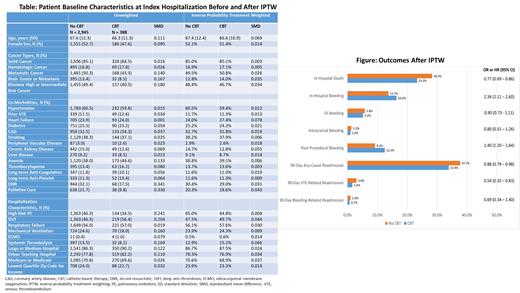Background: Pulmonary embolism (PE) is a well-known complication of cancer and is associated with significant morbidity and mortality. The standard of care for the treatment of PE is anticoagulation and systemic thrombolysis for high-risk PE. However, both carry risk of bleeding, and patients with cancer are particularly at higher risk of both bleeding and thrombotic complications. The development of catheter-based therapies (CBT) has provided an alternative reperfusion therapy for patients with high-risk and select intermediate risk PE patients. However, despite the increased prevalence of PE, patients with cancer are often excluded from clinical trials of invasive medical devices, including CBT for PE. Therefore, we investigated outcomes of patients with cancer hospitalized for intermediate or high-risk PE treated with or without CBT.
Methods: This was a retrospective cohort analysis of the National Readmission Database (NRD) of adult patients with a primary diagnosis of intermediate or high-risk PE from 2017 and 2018 with a history of cancer, which was identified using ICD-10 codes. High-risk PE was defined as PE with hemodynamic instability (either cardiac arrest, cardiogenic shock, or vasopressor use). Intermediate-risk PE was defined as PE with signs of right ventricular strain (type 2 myocardial infarction or cor pulmonale) without hemodynamic instability. Primary outcome was in-hospital mortality. Secondary outcomes were in-hospital major bleeding (composite of gastrointestinal, intracranial, and post-procedural bleeding), and 90-day any-cause, VTE-related, and bleeding-related readmissions. Propensity scores (PS) for estimating probability of CBT were calculated using non-parsimonious multivariable logistic regression that included all baseline patient characteristics examined. Inverse-probability treatment weighting (IPTW) was utilized to adjust for potential confounders. Patients treated with CBT were compared to those without and standardized mean difference (SMD) was calculated for variables before and after IPTW. Imbalances between groups were significant if SMD for any given covariable was ≥ 0.10. Hazard ratios (HR) were estimated for 90-day readmission outcomes using Cox proportional hazards regression, and odds ratio (OR) were calculated for estimating in-hospital outcomes using logistic regression.
Results: 3,333 patients were identified of which 388 (11.6%) were treated with CBT. Prior to IPTW, patients treated with CBT were younger (mean age 66.3 vs 67.6 years) and less likely to have metastatic cancer (43.3% vs 50.3%), Khorana high or intermediate risk cancer type (40.5% vs 49.4%) or high-risk PE (34.5% vs 46.3%), Table 1. After IPTW, baseline characteristics were well balanced between groups. After IPTW, CBT was associated with lower risk of in-hospital death (23.3% vs 28.3%, OR 0.77, 95% CI 0.69 - 0.86) but higher risk of in-hospital bleeding (16.4% vs 13.7%, OR 2.34, 95% CI 2.11 - 2.60) which was driven by post-procedure bleeding (12.5% vs 9.2%, OR 1.40, 95% CI 1.20 - 1.64). CBT was also associated with lower 90-day any-cause (HR 0.88, 95% CI 0.79 - 0.98) and VTE-related (HR 0.54, 95% CI 0.35 - 0.83) but not bleeding-related (HR 0.69, 95% CI 0.34 - 1.40) readmissions, Figure 1.
Conclusions: Patients with cancer admitted with intermediate or high-risk PE have high rates of in-hospital death and bleeding. Treatment with CBT was associated with lower in-hospital death and 90-day any-cause and VTE-related readmissions at the cost of increased in-hospital bleeding driven by post-procedural bleeding. Prospective studies and trials of CBT in PE should include patients with cancer and further investigation is warranted to confirm our findings.
Disclosures
Rosovsky:Penumbra: Consultancy, Other: National Lead Investigator for STORM PE; Janssen: Consultancy, Other: Research funding is to my institution, Research Funding; Abbott: Consultancy; Dova: Consultancy; BMS: Consultancy; Pulmonary Embolism Response Team: Membership on an entity's Board of Directors or advisory committees, Other: President-Elect; Inari: Consultancy.


